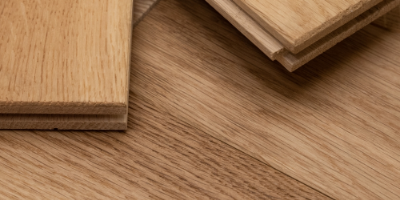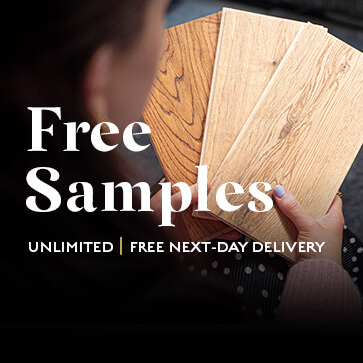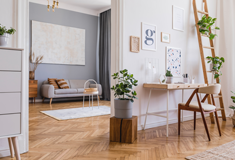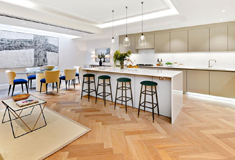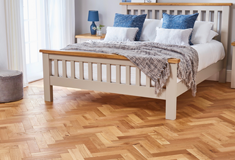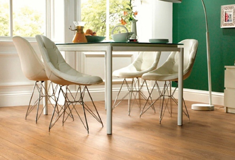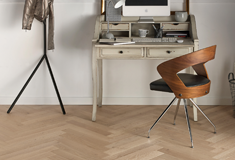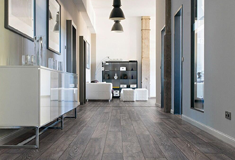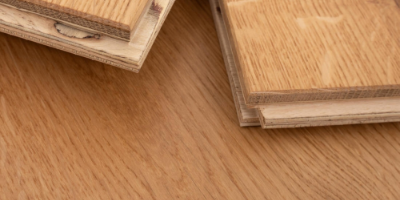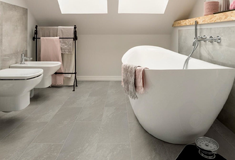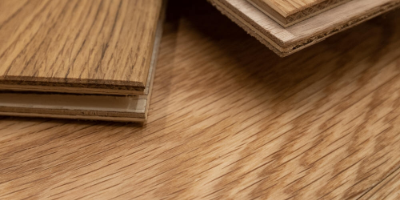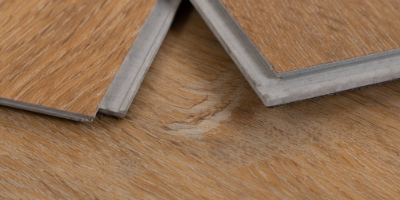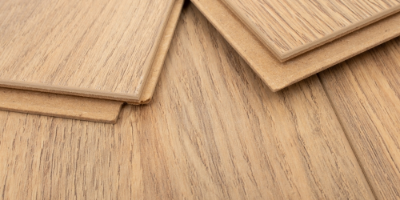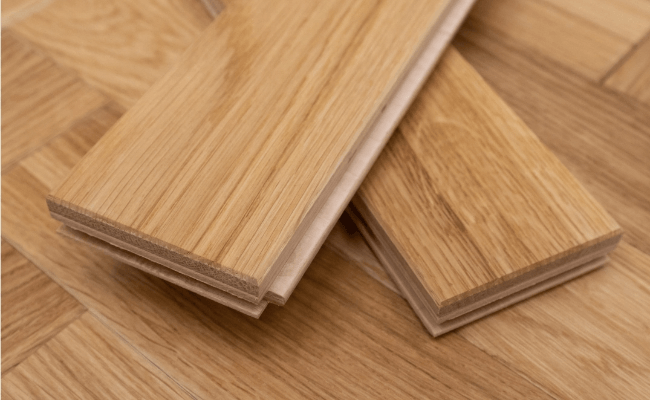What is Engineered Wood Flooring?
is crafted with a top layer of solid wood veneer, to give the appearance of solid wood flooring for a fraction of the price.
The under layers are made from softwood, plywood or HDF (high density fibreboard), all of which are strong and supportive to ensure the flooring doesn’t warp or shrink over time.
As well as offering the look and feel of real wood flooring, engineered wood can be fitted in areas not recommended for solid wood, such as kitchens and conservatories. This is because engineered wood is much more resilient to changes in moisture and humidity. Engineered wood flooring can also be laid over underfloor heating.
Types of Engineered Wood
If you’re wondering what to look for in engineered wood flooring, there are a number of different considerations to make.
In the guide below we’ve broken down the various types of engineered wood flooring, including the construction, species, finishes, grades and edging options.
All our engineered wood floors are Underfloor Heating compatible and come with a 25-year warranty.
Jump to section:
Engineered Wood Construction
Before you begin considering the look of your floor, you should first think about the construction. Once engineered wood is installed you won’t be able to tell the difference, thanks to the real wood top layer, but the construction chosen can have implications depending on the environment where it will be installed.
There are two different ways in which our engineered flooring is constructed:
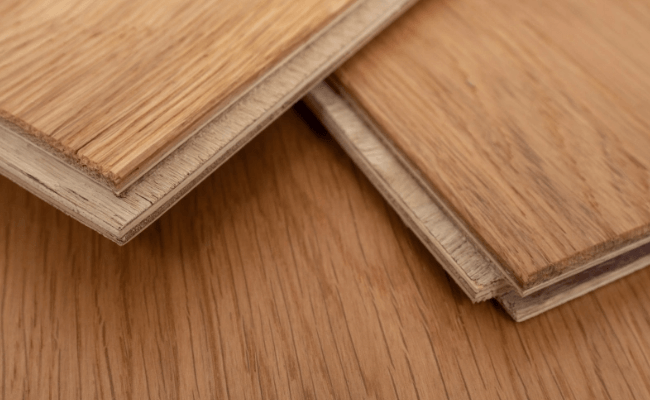
Multi ply engineered flooring is made by tightly fusing together many layers of plywood to make the main body of the board, then a real wood veneer is added on top. It’s the strongest engineered option and suitable to be installed on all types of subfloor, plus it can be used with underfloor heating systems.
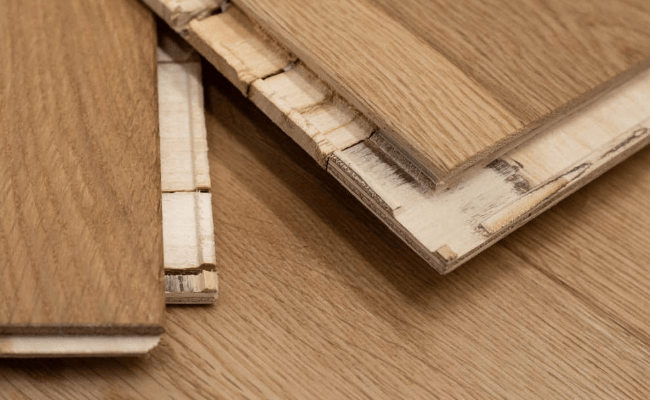
Like multi ply, three ply engineered wood flooring is made with a top layer of real hardwood and two layers of plywood or softwood. It’s typically cheaper than multi ply, though still almost as strong and able to resist moisture changes.
Engineered Wood Floor Species
There are different species of wood available for your engineered flooring. Below we’ve broken down each one so you can make the most informed choice:
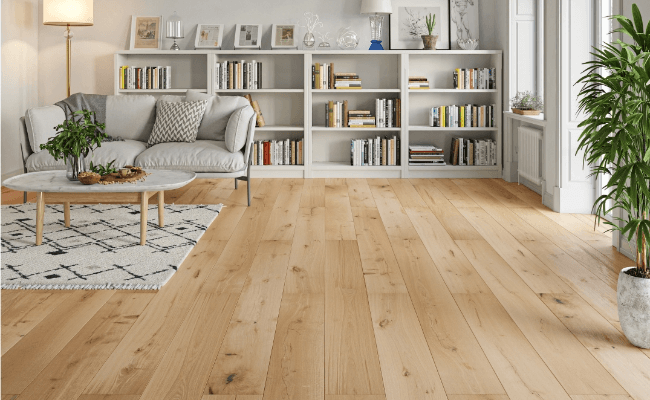
Oak engineered flooring is usually recognisable by the straight and looping grain patterns, and the knots in the wood, offering a traditional and natural look. Oak is a popular choice for engineered flooring and we stock an array of colours in a variety of different sizes and finishes. All our oak is grown in Europe, ensuring great quality and consistency with every board.
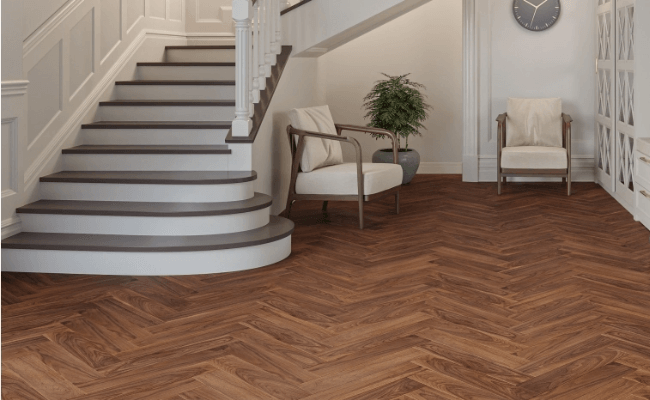
Walnut is a rich dark wood that stands out due to its graining patterns, burrs and knots. Graining patterns can be linear or irregular, which gives walnut engineered flooring a unique look compared to other wood species. As a naturally dark wood, walnut tends to become slightly lighter over time in direct sunlight.
Engineered Wood Floor Finishes
The finish of your engineered flooring is important to achieve the look you want, as well as provide the level of protection you need.
Here are each of the finishes you can consider:
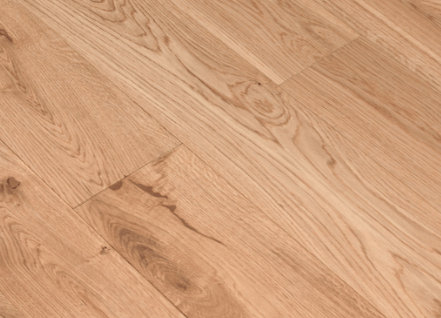
Lacquered engineered flooring has a smooth finish as the lacquer sits on top of the wood, creating a protective layer. This means it’s easy to clean and resistant to spills. The lacquer creates a glossy, polished finish that reflects light in the room, making it appear brighter and more spacious. Lacquer also protects your flooring from sunlight more effectively than oiled floors.
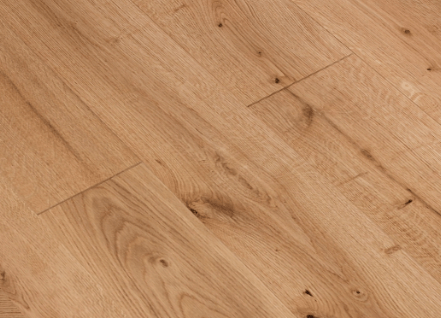
Oiled engineered wood has become increasingly popular as more people are opting for a natural look. The other factor that adds to its appeal, is that unlike a lacquered finish, oil seeps into the wood providing a gorgeous rustic aesthetic. Also, if part of your engineered floor is damaged, you can simply sand it down and reapply the oil to the affected area, while with lacquered wood you’ll need to sand down the whole room. That said, it’s worth noting that oiled wood flooring will show the effects of direct sunlight more than its lacquered alternative.
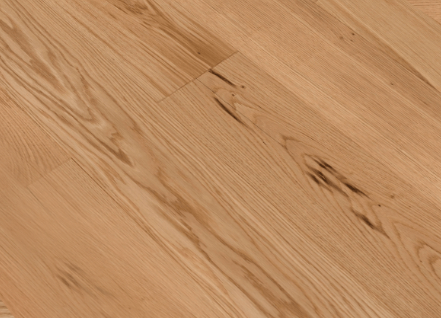
Brushed and oiled wood will create a more natural look in your room, perfect for woodsy cabins or a rustic chic space. To achieve this effect, a wire brush is used to remove the fresh wood, exposing the older wood underneath with its traditional grain, knots and rings. This technique gives the flooring a lot of character and helps to hide any scratches that might appear in the future. The oil soaks in, strengthening the wood and enhancing its natural beauty. It does need to be re-oiled every now and then, but this is a relatively easy task.
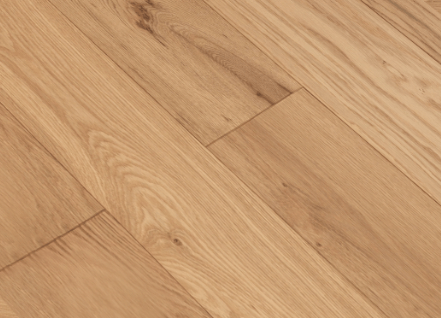
Brushed and lacquered wood flooring gives you a similar natural look to brushed and oiled floors, as the knots, rings and grain patterns are exposed during the wire brushing process. As this engineered flooring is also lacquered, you get a traditional look with a strong protective coating. Plus, it’s easy to maintain and the lacquer protects your wood against sunlight.

Hand scraped engineered flooring offers an aged, worn and very individual statement to your room. This flooring used to be incredibly expensive as it was highly labour intensive to hand carve each board. However, advances in flooring machinery have meant the hand scraped look can now be replicated easily, making it available at a much more affordable price. Our hand scraped engineered wood flooring is available in a variety of different species and finishes so you’re bound to find a floor to suit your taste.
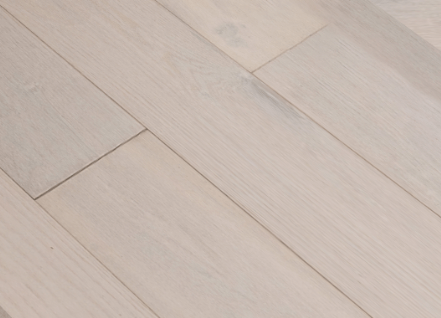
White washed engineered wood is simply brushed and then coated with a white stain, creating a clean, elegant look. White washed floors work well in dark rooms, brightening your living space and making it more inviting.
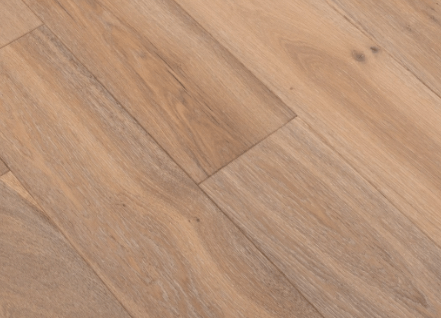
Smoked engineered flooring is created by leaving the wood in a confined environment with ammonia in the atmosphere. The ammonia in the air helps the wood turn darker and produces a hard-wearing wood with an attractive aged look.
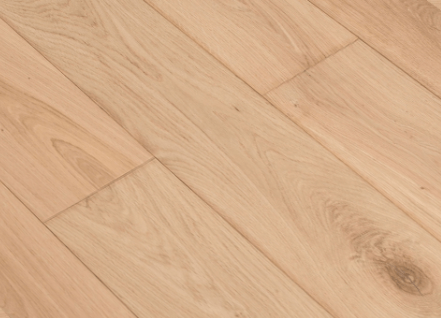
You can opt for unfinished engineered flooring so that you can design your own finish to make it more personal to you. This allows you to create a truly bespoke floor. We recommend that you experiment on unfinished wood samples first, to achieve the look that you desire.
Engineered Wood Floor Grades
Grades are important when considering what to look for in engineered wood flooring.
Wood has naturally occurring knots, variations in colour and different grain patterns. When engineered flooring is lumbered, it’s graded for quality.
Here are the different grades of wood:
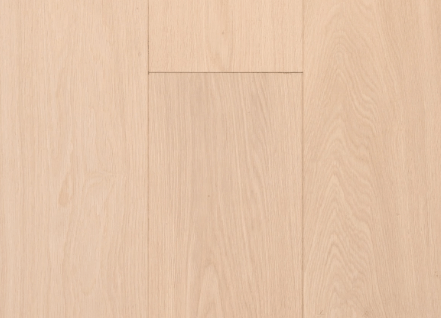
Prime graded wood is the number one in grading. This wood has a minimal amount of small knots giving it a uniform appearance, perfect for a contemporary living space.

Rustic graded wood looks simpler and more natural, due to its increased number of knots, natural grain patterns and colour variation. Sometimes filler is used on knots and splits in rustic wood, but don’t worry, it doesn’t look out of place in this characterful style. Rustic grade wood is by far the most popular grade thanks to its unrivalled natural appearance.
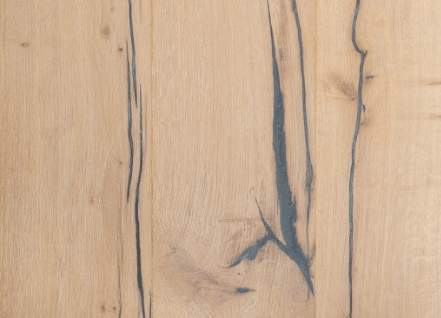
Distressed flooring is specially treated to intentionally create an aged and worn look. Stain, colour wash and an embossing roll are used to produce a distressed design with pits and nail holes which add to its character. This type of wood is ideal for well-used areas of your home, as dents and marks will only add to its unique beauty.
Engineered Wood Floor Plank Effects
The construction of your engineered floorboards and the size and arrangement of the planks will alter the appearance of your room. We explain the differences below:
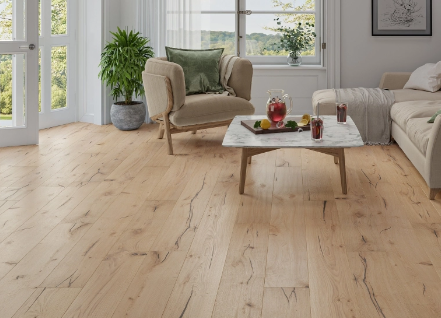
Single planks are the most common option for engineered wood flooring. This is the long-established process of cutting one plank of wood from a tree and manufacturing it into a board. This ensures the flooring looks natural, and the structure and grain of the wood can be appreciated. Single planks also have the benefit of making your room appear larger.
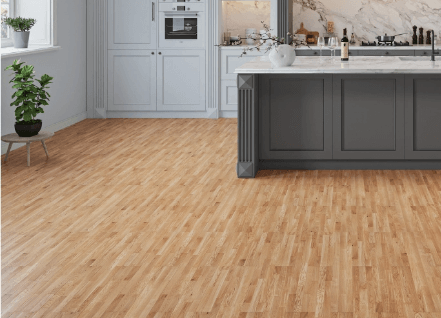
Multi strip and three strip plank engineered flooring is formed by combining small strips of wood to create one board. This makes it a slightly cheaper alternative compared to single plank floors. Boards made from multiple strips of wood can work well in smaller rooms as they give the impression of more space.
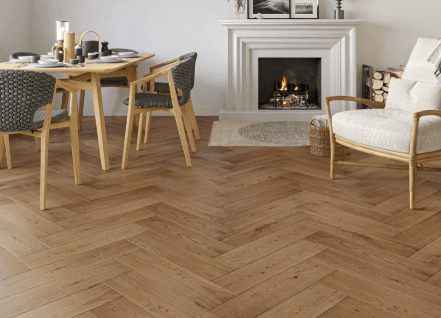
The geometric patterns of parquet engineered flooring add character to your home. Our engineered parquet flooring is indistinguishable from solid wood flooring, and adds even more durability and strength.
Herringbone – This popular style of flooring consists of alternating rows of short wood boards in slanted parallel lines to create an eye-catching uniform finish. Herringbone engineered flooring can be a challenge to install, due to the multitude of small boards that must be aligned perfectly.
Chevron - Straight vertical lines between two rows of slanted wood boards, create this distinctive pattern. Chevron engineered flooring is ideal for professional environments thanks to its uniform appearance.
Engineered Wood Flooring Edge Profiles
When choosing your engineered flooring you’ll want to think about the edging of the boards, to get your desired finish.
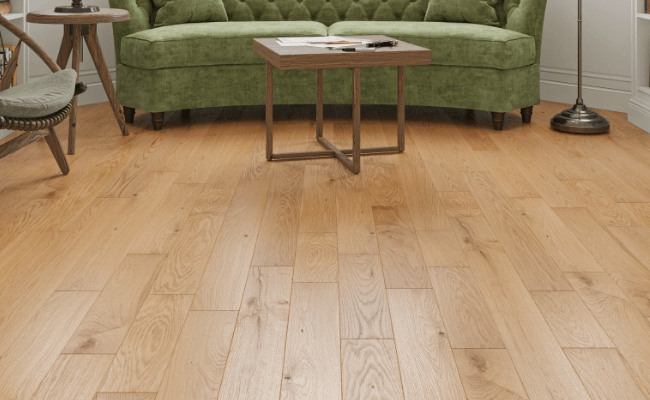
To create a more natural look, bevelled edges make a groove between each of your engineered flooring planks. They add personality to your floor and cleverly hide any gaps that may develop between your boards over time. Bevelled edges are by far the most popular option due to their authentic look.
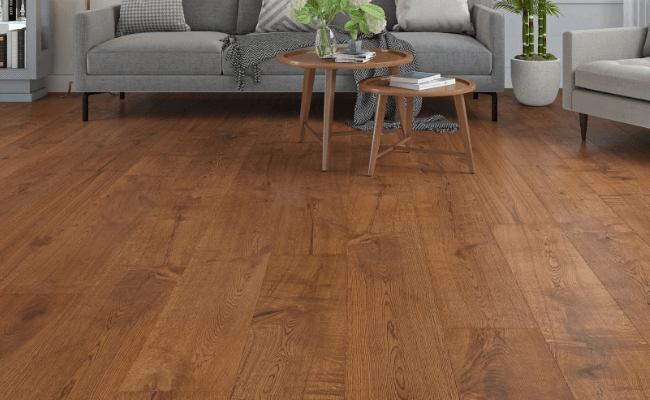
A square edged board means that each plank fits together seamlessly to create a smooth and orderly floor with no visible spaces. Each of your engineered flooring planks is blended together, giving your room a sleek, uniform look.
Engineered Wood Flooring Joining Methods
Engineered wood flooring can be joined via a click system or traditional Tongue & Groove method. We break down the differences in how to install engineered wood flooring below:
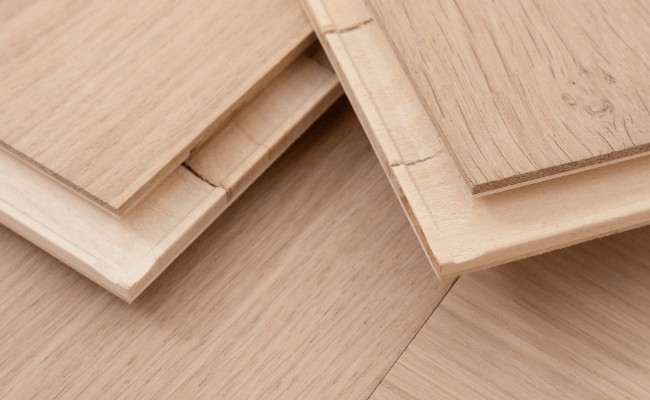
Click Fit
Engineered wood flooring can be fitted easily through a click fit system. You don’t need glue, nails or much equipment, as the planks are designed to simply click together. For this reason, the system is popular with homeowners who want to do the job themselves.
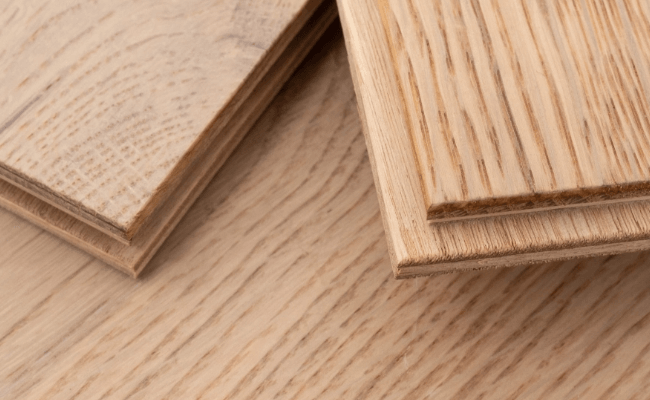
Tongue & Groove
Tongue & Groove engineered flooring planks fit together perfectly to create a smooth surface without any gaps. One side of the plank has a protruding edge and the other has a rebated edge to ensure this perfect finish. A major benefit of Tongue & Groove engineered flooring is that, using nails or glue, it can be installed on any type of subfloor.
Why Choose Engineered Wood Flooring?
You should choose engineered wood flooring if you want the beauty and durability of real wood, at a more affordable price.
Practically, engineered wood is hard-wearing and more resilient to changes in moisture and humidity, making it ideal for areas such as kitchens and conservatories. It’s also less susceptible to movement, because only the top layer is made of real hardwood.
As you can see by exploring the different species and finishes above, you can truly tailor your engineered wood flooring to create a look and finish you love.

Need a little help choosing the right floor for your home?
Simply request a callback and one of our friendly flooring experts will be in touch as soon as possible.

